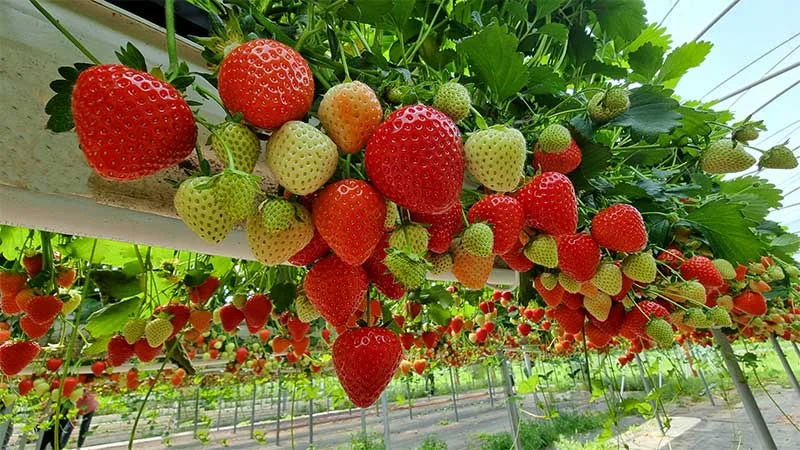Growing strawberries without soil might sound futuristic, but it’s an accessible and rewarding reality. Hydroponic strawberries harness innovation and sustainability, yielding luscious berries regardless of climate and season.
What Are Hydroponic Strawberries?
Hydroponic strawberries are simply strawberries grown in nutrient-enriched water, without soil. Their roots absorb precisely tailored minerals from the water, eliminating common soil-borne diseases and pests. This method allows growers control over every growth aspect, producing consistently healthy and abundant fruit.
Strawberries thrive in hydroponics due to their shallow root systems and preference for precise nutrient delivery. Instead of battling unpredictable soil conditions, growers can focus on creating the ideal environment for plant health, flavor, and yield.
The Main Benefits of Growing Hydroponic Strawberries
-
Year-Round Harvests: Controlled growing conditions mean fresh strawberries are available even in winter.
-
Water Conservation: Hydroponics uses up to 90% less water than soil-based agriculture, a crucial benefit as water scarcity increases globally.
-
Space Efficiency: Compact layouts and vertical farming make hydroponic strawberry plants perfect for urban homes or small gardens.
-
Fewer Chemicals: The clean, closed environment means far less need for pesticides or herbicides.
-
Higher Yields: Better control leads to more frequent flowering and fruiting cycles, maximizing output.
Choosing the Best Strawberry Hydroponic System
Several methods exist for cultivating hydroponic strawberries. Each strawberry hydroponic system has unique benefits suited for different circumstances.
-
Deep Water Culture (DWC): Plants suspend their roots in oxygenated, nutrient-rich water. DWC is user-friendly and requires minimal maintenance, making it popular with beginners.
-
Nutrient Film Technique (NFT): A thin film of water flows across plant roots in sloped channels, delivering nutrients and oxygen. NFT is ideal for small spaces and vertical growing, though it requires more technical setup.
-
Drip System: Delivers nutrient solution directly to each plant’s base. It offers great efficiency and precise control of water and nutrients.
-
Ebb and Flow: The root zone is submerged in the nutrient solution periodically, then drained. This pulse irrigation supports rapid growth and is widely used in commercial setups.
Selecting a system depends on available space, budget, technical skill, and production goals. For home growers, a simple NFT or DWC system with vertical stacking maximizes plants per square foot.
Selecting Hydroponic Strawberry Plants or Varieties
Choose “day-neutral” or “everbearing” varieties for year-round fruiting. Popular choices include Albion, Seascape, and Tribute. “June-bearing” strawberries have a strong but short fruiting burst, suitable if aiming for a concentrated harvest period.
Purchase disease-free, healthy young plants for faster results. Growing from seed is possible but much slower, as seedlings may take a year or more to produce fruit.
Step-by-Step: Planting Hydroponic Strawberries
-
Prepare Net Pots and Growing Medium: Fill containers with an inert substrate like coco coir, clay pebbles, or a mix with perlite. These provide root stability and moisture.
-
Transplant Carefully: Rinse soil from roots before placing starter plants into net pots. Bury roots but keep the crown above the medium to prevent rot.
-
Position in Your Hydroponic System: Ensure roots access water or nutrient film while staying aerated. Adjust for even light distribution.
-
Initial Watering: After transplant, provide a mild nutrient solution to reduce transplant shock.
Nutrients and Water Quality
Hydroponic systems require precision in feeding. Use a complete hydroponic fertilizer with an NPK ratio close to 6-3-9 or adjusted per growth stage (more nitrogen early, more potassium during fruiting).
-
Monitor EC and pH: Check electrical conductivity (EC) levels weekly; strawberries thrive at 1.8–2.2 mS/cm.
-
pH range: Optimal is 5.5–6.5. Out-of-range water leads to nutrient lockout and stress.
-
Change Solution Regularly: Replace the reservoir every 7–14 days to avoid imbalances or disease build-up.
Always use filtered water to safeguard plants from harmful impurities.
Light and Environmental Controls
-
Light: 12–16 hours of good-quality light daily is necessary. Use full-spectrum LED grow lights for indoor setups, or site systems where outdoor sunlight is available.
-
Temperature: Target 65–75°F (18–24°C) in day, with gentle nighttime cooling for best growth.
-
Humidity: 60–70% relative humidity prevents leaf stress while discouraging fungal diseases, with occasional air movement from fans.
Pollination and Fruit Development
Strawberries in open environments get pollinated by insects and wind. In enclosed hydroponic systems, gently brush the centers of flowers with a small paintbrush daily, or run an oscillating fan to mimic wind.
Common Challenges and Solutions
-
Root Rot: Ensure adequate aeration and avoid warmth in the root zone.
-
Nutrient Deficiencies: Regularly check nutrient mix and pH.
-
Pest Control: Inspect plants weekly; hydroponics reduces pests, but spider mites and aphids can appear.
Harvest and Enjoyment
Harvest hydroponic strawberries when they are fully red, plump, and slightly glossy. Use sharp, clean scissors to cut them just above the cap, preserving plant health for the next fruit cycle.
Sustainability and the Future of Strawberry Farming
Hydroponic strawberry farming is at the forefront of sustainable agriculture. According to a peer-reviewed summary from the National Center for Biotechnology Information, hydroponics represents a key innovation in smart farming, maximizing yield while minimizing environmental impact. Large-scale adoption by leaders like Driscoll’s signals mainstream acceptance of these methods.
High-Authority Reference
For further in-depth, science-backed research, see:
Rajaseger, G. et al. “Hydroponics: current trends in sustainable crop production.” National Center for Biotechnology Information, 2023.









